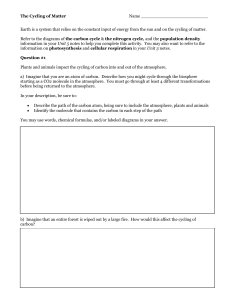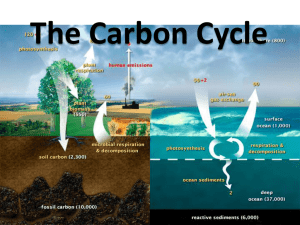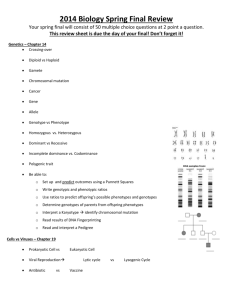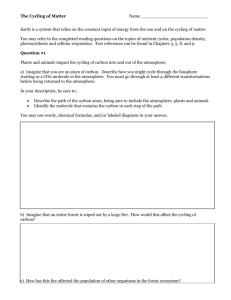Science - Unit 1 - 2.1 The Transfer of Energy in Ecosystems Note
advertisement
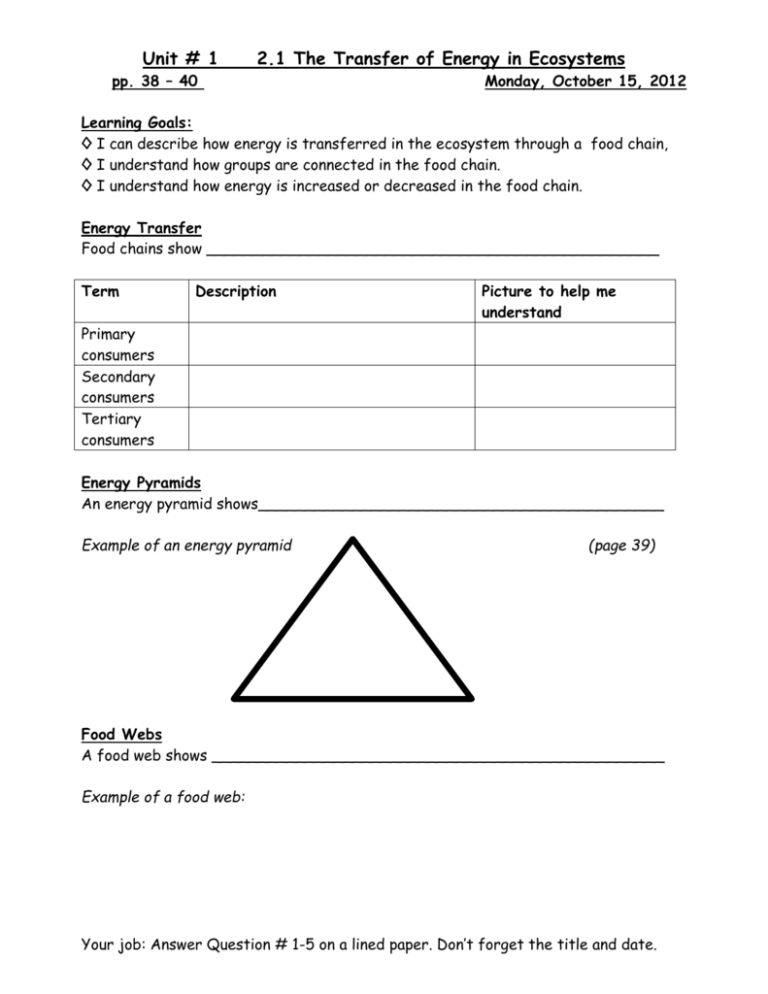
Unit # 1 2.1 The Transfer of Energy in Ecosystems pp. 38 – 40 Monday, October 15, 2012 Learning Goals: ◊ I can describe how energy is transferred in the ecosystem through a food chain, ◊ I understand how groups are connected in the food chain. ◊ I understand how energy is increased or decreased in the food chain. Energy Transfer Food chains show ________________________________________________ Term Description Picture to help me understand Primary consumers Secondary consumers Tertiary consumers Energy Pyramids An energy pyramid shows___________________________________________ Example of an energy pyramid (page 39) Food Webs A food web shows ________________________________________________ Example of a food web: Your job: Answer Question # 1-5 on a lined paper. Don’t forget the title and date. Unit # 1 2.2 Cycling Matter pp. 33 – 44 _________, October , 2012 Learning Goals: ◊ I can describe how decomposers break down organic matter in order to recycle basic elements. ◊ I can identify carbon, nitrogen, and phosphorus atoms as basic elements of matter that are cycled in ecosystems. ◊I can describe cycling interactions and how they change our ecosystem. Cycling Organic Matter Cycling matter is ___________________________________________________ Benefits of cycling matter: Changes Resulting from Cycling Matter Example of the cycling of matter in an ecosystem (page 45). Unit # 1 2.3 Interactions and Changes in the Ecosystem pp. 48 – 44 54 Monday, October 22, 2012 Learning Goals: ◊ I can describe how changes in the supply of resources will disrupt the interactions in an ecosystem. ◊ I can identify examples of changes in resources in an ecosystem and explain how they can threaten the survival of biotic elements in an ecosystem. A_____ f____, __________, _____________, and s__________, are all factors that control or limit the number of health of biotic elements in an ecosystem is called _________________. (page 48) Why Ecosystems Change: (page 49) 1. Flow of energy and the cycling of matter. 2. ______________________________________________________________ 3. ______________________________________________________________ 4. ______________________________________________________________ 5. ______________________________________________________________ Change is ________ happening in the ecosystem! Bio invasion (page 49-50) Bioinvasion is a term used to describe ___________________________________ ________________________________________________________.(page 49) Types of Species Native species Description Picture Example Introduced species Invasive species Competition (page 50) What is competition? Competition is ____________________________________ ________________________________________________________________ Sustainability RECAP – Things we have learned so far….! Draw a summary of the following concepts. Producers Page 18 Consumers Page 24 Decomposers Page 26 Interaction Energy transfer Page 39 Cycling of matter Page 44 Competition Page 50 Bioinvasion Page 49 A 26 Lab: Problem Solving Activity – Redesign a Package (page 46) Skills you will use ■ Identifying a problem ■ Re - Designing, creating/ building Recognize a Need: Most goods sold in Canada must be shipped long distances. The goods must arrive in perfect condition and often require a lot of label information. Most packaging ends up as waste in landfills or ecosystems. If it is not made of organic matter, decomposers cannot break it down. Problem: How can you make a secure package that can be broken down by decomposers? Criteria for Success: Your model addresses the following issues: ■ the package can be broken down by decomposers ■ labeling requirements (required customer information) are met ■ goods in the package are not damaged in transit ■ the package is appealing to customers Brainstorm Ideas 1. Research the packaging for any one of the items listed. Answer the following questions: How is the item protected? How is it transported? How is it sold? What happens to the packaging? 2. What is the impact of the packaging on the environment? Can decomposers break it down? How long will it take? 3. What packaging alternatives would be better for the environment? Build a Model 4. Create a package that meets the criteria for success but at the same time reduces the amount of packaging that would end up as waste. My Package Idea: Test and Evaluate 5. Using your new package, transport your item along the hall and up or down the stairs to another floor at the other end of the school using a custodian’s two-wheeled device to transport it. Did your package meet the criteria for success? 6. Share and compare your ideas and findings with your classmates’ plans and findings. Did anyone have ideas exactly like yours? Similar to yours? Completely different from yours? How do your results compare with theirs?



